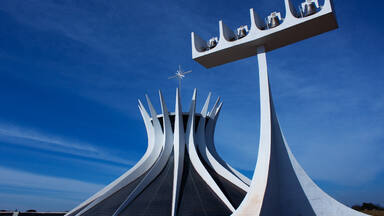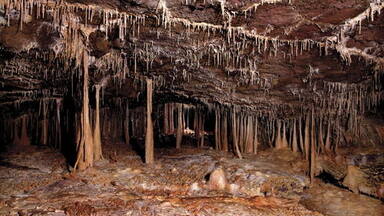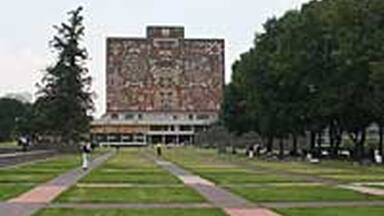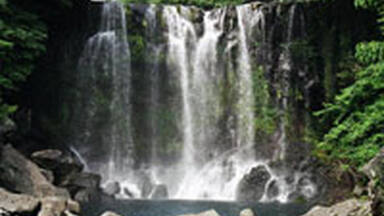Jeju Volcanic Island and Lava Tubes
Jeju Volcanic Island and Lava Tubes
Jeju Volcanic Island and Lava Tubes together comprise three sites that make up 18,846 ha. It includes Geomunoreum, regarded as the finest lava tube system of caves anywhere, with its multicoloured carbonate roofs and floors, and dark-coloured lava walls; the fortress-like Seongsan Ilchulbong tuff cone, rising out of the ocean, a dramatic landscape; and Mount Halla, the highest in Korea, with its waterfalls, multi-shaped rock formations, and lake-filled crater. The site, of outstanding aesthetic beauty, also bears testimony to the history of the planet, its features and processes.
Description is available under license CC-BY-SA IGO 3.0
Île volcanique et tunnels de lave de Jeju
L’Île volcanique et les tunnels de lave de Jeju comprennent trois sites qui représentent un total de 18 846 ha. Geomunoreum est considéré comme le plus remarquable réseau de tunnels creusés dans les laves du monde avec ses dépôts et décorations carbonatés; le cône de tuf de Seongsan Ilchulbong s’élève comme une forteresse au-dessus de la mer, créant un paysage exceptionnel ; le mont Halla est le plus haut sommet de Corée, avec ses chutes d’eau, ses formations de pierres aux profils variés et son cratère devenu lac. Le bien, d’une beauté extraordinaire, est aussi un témoignage de l’histoire de notre planète, de ses caractéristiques et processus.
Description is available under license CC-BY-SA IGO 3.0
جزيرة جيجو البركانية وأنابيب الحمم
تشمل الملكية ثلاثة مواقع ممتدة على مساحة 846 18 هكتار، أي ما يعادل 10،3% من مساحة جزيرة جيجو الواقعة في أقصى جنوب جمهورية كوريا. وتحتوي على: جيومونوريوم، التي تُعدّ أهم شبكة لأنابيب الحمم في العالم، مع أرضيتها وسقفها المكونين من الكربونات المتعدد الألوان، وجدرانها الملونة بالحمم الداكنة؛ سيونغسان إيلشولبونغ، وهو حجر مسامي مخروطي متشكِّل من رماد البراكين، يتصاعد من المحيط على شكل حصن في مشهد مثير الدهشة؛ جبل هالاسان (الأكثر ارتفاعاً في كوريا) بشلالاته وأشكاله الصخرية المتعددة، وفوّهة بركانه التي تحولت إلى بحيرة. يتسم الموقع بجمال استثنائي ويشهد على تاريخ كوكبنا.
source: UNESCO/CPE
Description is available under license CC-BY-SA IGO 3.0
济州火山岛和熔岩洞
济州火山岛和熔岩洞位于大韩民国最南端,由三部分组成,占地面积18 846公顷,为济州岛面积的10.3%。遗产包括:地质遗址、绚丽多彩的碳酸盐洞顶和地面、纯黑色的熔岩洞壁、被视为最完美的熔岩洞窟体系;日出峰、由凝灰岩构成的锥形山峰,如堡垒般矗立在海边,景色令人叹为观止;韩国最高峰——汉拿山,以瀑布、形态各异的岩石和火山口湖泊而闻名。济州火山岛和熔岩洞不仅美丽绝伦,而且见证了地球的发展、特点和进化过程。
source: UNESCO/CPE
Description is available under license CC-BY-SA IGO 3.0
Вулканический остров Джеджу с его лавовыми туннелями
Вулканический остров Джеджу с его лавовыми туннелями состоит из трех частей общей площадью в 18 846 га. Это - 10,3 % поверхности самого южного острова Республики Корея - Джеджу. Геомунореум, знаменитейшая галерея из туннелей и пещер, известна своими разноцветными карбонатными потолочными сводами и проходами и сформированными из лавы стенами темных тонов. Конусообразная скала из туфа Сеонгсан Илчулбонг словно крепость возвышается над поверхностью океана, производя на наблюдателя театральный эффект. На острове также находится самая высокая в Корее гора Халласан, впечатляющая разнообразными по форме каменными образованиями, живописными водопадами и заполнившимся водой кратером-озером. Этот исключительный по красоте памятник природного наследия свидетельствует об истории нашей планеты, ее строении и происходивших на ней геофизических процессах.
source: UNESCO/CPE
Description is available under license CC-BY-SA IGO 3.0
Paisaje volcánico y túneles de lava de la Isla de Jeju
El sitio comprende tres áreas que suman 18.846 hectáreas, o sea el 10,3% de la superficie de la isla de Jeju, que es la porción más meridional del territorio de la República de Corea. Las tres áreas son: el Geomunoreum, considerado como la red de grutas formadas por túneles de lava más bella del mundo, con techos y suelos carbonatados multicolores y paredes oscuras de lava; el cono de tuf de Seongsan Ilchulbong, parecido a una fortaleza surgida de las aguas del océano, que forma un paisaje espectacular; y el monte Hallasan, la cumbre más alta de Corea, con sus cascadas, sus formaciones rocosas de múltiples configuraciones y su cráter ocupado por un lago. El sitio no sólo es de una belleza fuera de lo común, sino que además constituye un testimonio de las características y procesos de la historia geológica de nuestro planeta.
source: UNESCO/CPE
Description is available under license CC-BY-SA IGO 3.0
済州火山島と溶岩洞窟群
韓国最南端の火山島である済州島では、漢拏山自然保護区、城山日出峰、拒文岳溶岩洞窟群の3地域、合わせて約188.5k㎡が世界遺産に登録された。漢拏山自然保護区は、韓国最高峰の漢拏山(1950m)を中心に広がり、火山活動で生まれた滝や奇岩怪石、火山湖などの優れた景観美が特徴で、高山植物の宝庫でもある。島の東端にある城山日出峰は海底噴火により誕生したもので、海面上に盛り上がり、山頂に巨大な噴火口を残す。また、約30万~10万年前に拒文岳の噴火に伴って生まれた拒文岳溶岩洞窟群は、その長さや複雑さが特徴的だ。いずれも地球の形成や進化の歴史に関する重要な証明となっている。source: NFUAJ
Vulkanisch eiland Jeju en lavagrotten
Het vulkanisch eiland Jeju en zijn lavagrotten vormen samen drie locaties die zich uitstrekken over een gebied van 18.846 hectare. Het gebied omvat Geomunoreum dat wordt beschouwd als het mooiste lavagrottenstelsel ter wereld. Het heeft veelkleurige carbonaten gewelven en vloeren en donkergekleurde lavamuren. Verder liggen er de fortachtige kegel van tufsteen Seongsan Ilchulbong die oprijst vanuit de oceaan en de berg Halla – de hoogste in Korea – met zijn watervallen, veelvormige rotsformaties en in een met een meer gevulde krater. De omgeving is van grote esthetische schoonheid en getuigt van de geschiedenis, de functies en processen van de aarde.
Source: unesco.nl
Outstanding Universal Value
Jeju Volcanic Island and Lava Tubes is a coherent serial property comprising three components. The unequalled quality of the Geomunoreum lava tube system and the exhibition of diverse and accessible volcanic features in the other two components demonstrate a distinctive and important contribution to the understanding of global volcanism.
Criterion (vii): The Geomunoreum lava tube system, which is regarded as the finest such cave system in the world, has an outstanding visual impact even for those experienced with such phenomena. It displays the unique spectacle of multi-coloured carbonate decorations adorning the roofs and floors, and dark-coloured lava walls, partially covered by a mural of carbonate deposits. The fortress-like Seongsan Ilchulbong tuff cone, with its walls rising out of the ocean, is a dramatic landscape feature, and Mount Halla, with its array of textures and colours through the changing seasons, waterfalls, display of multi-shaped rock formations and columnar-jointed cliffs, and the towering summit with its lake-filled crater, further adds to the scenic and aesthetic appeal.
Criterion (viii): Jeju has a distinctive value as one of the few large shield volcanoes in the world built over a hot spot on a stationary continental crust plate. It is distinguished by the Geomunoreum lava tube system, which is the most impressive and significant series of protected lava tube caves in the world and includes a spectacular array of secondary carbonate speleothems (stalactites and other decorations), with an abundance and diversity unknown elsewhere within a lava cave. The Seongsan Ilchulbong tuff cone has exceptional exposures of its structural and sedimentological characteristics, making it a world-class location for understanding Surtseyan-type volcanic eruptions.
The property is well managed and resourced, with a management plan in place for the period 2006-2010 and resources for its implementation. Key management issues include avoiding potential agricultural impact on the underground environment and managing the high number of visitors to the property. There is potential for further extension of the property to include other significant lava tube systems and volcanic features of Jeju.
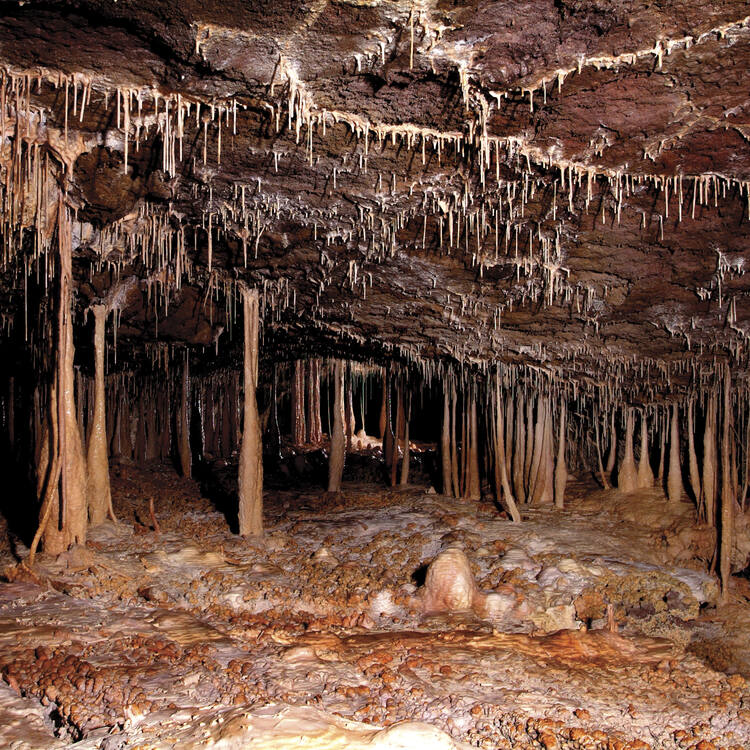
 View photos from OUR PLACE the World Heritage collection
View photos from OUR PLACE the World Heritage collection